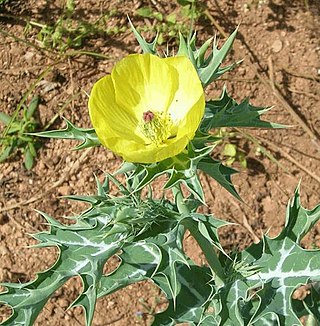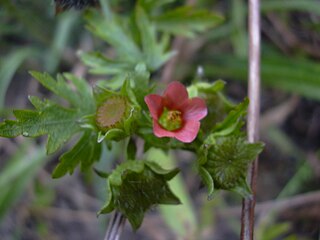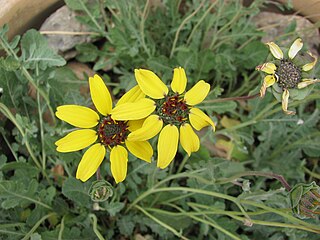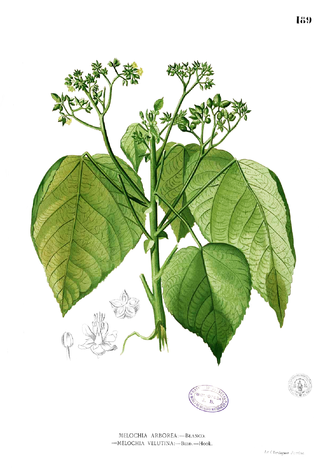
Abutilon is a large genus of flowering plants in the mallow family, Malvaceae. It is distributed throughout the tropics and subtropics of the Americas, Africa, Asia, and Australia. General common names include Indian mallow and velvetleaf; ornamental varieties may be known as room maple, parlor maple, or flowering maple. The genus name is an 18th-century Neo-Latin word that came from the Arabic ’abū-ṭīlūn, the name given by Avicenna to this or a similar genus.

Coreopsis is a genus of flowering plants in the family Asteraceae. Common names include calliopsis and tickseed, a name shared with various other plants.

Sphaeralcea is a genus of flowering plants in the mallow family (Malvaceae). There are about 40-60 species, including annuals, perennials, and shrubs. Most originate in the drier regions of North America, with some known from South America. They are commonly known as globemallows, globe mallows, false mallows or falsemallows. The name of the genus is derived from the Greek words σφαῖρα (sphaira), meaning "sphere," and αλκεα (alkea), meaning "mallow."

A wildflower is a flower that grows in the wild, meaning it was not intentionally seeded or planted. The term implies that the plant is neither a hybrid nor a selected cultivar that is any different from the native plant, even if it is growing where it would not naturally be found. The term can refer to the whole plant, even when not in bloom, and not just the flower.

Cercocarpus, commonly known as mountain mahogany, is a small genus of at least nine species of nitrogen-fixing flowering plants in the rose family, Rosaceae. They are native to the western United States and northern Mexico, where they grow in chaparral and semidesert habitats and climates, often at high altitudes. Several are found in the California chaparral and woodlands ecoregion.

Amorpha is a genus of plants in the pea family, Fabaceae. All the species are native to North America, from southern Canada, most of the United States (US), and northern Mexico. They are commonly known as false indigo. The name Amorpha means "deformed" or "without form" in Greek and was given because flowers of this genus only have one petal, unlike the usual "pea-shaped" flowers of the Faboideae subfamily. Amorpha is missing the wing and keel petals.

Krameria is the only genus in the Krameriaceae family, of which any of the approximately 18 species are commonly known as rhatany, ratany or rattany. Rhatany is also the name given to krameria root, a botanical remedy consisting of the dried root of para rhatany or Peruvian rhatany.

Chamaedorea is a genus of 107 species of palms, native to subtropical and tropical regions of the Americas. They are small palms, growing to 0.3–6 m tall with slender, cane-like stems, growing in the understory in rainforests, and often spreading by means of underground runners, forming clonal colonies. The leaves are pinnate, with one to numerous leaflets. The flowers are produced in inflorescences; they are dioecious, with male and female flowers on separate plants. The fruit is an orange or red drupe 0.5–2 cm diameter. Perhaps the best-known species is Chamaedorea elegans from Mexico and Guatemala. It is popular as a houseplant, particularly in Victorian houses. Another well-known species is Chamaedorea seifrizii, the bamboo palm or reed palm.

Baptisia is a genus in the legume family, Fabaceae. They are flowering herbaceous perennial plants with pea-like flowers, followed by pods, which are sometimes inflated. They are native to woodland and grassland in eastern and southern North America. The species most commonly found in cultivation is B. australis.

Argemone is a genus of flowering plants in the family Papaveraceae commonly known as prickly poppies. There are about 32 species native to the Americas and Hawaii. The generic name originated as ἀργεμώνη in Greek and was applied by Dioscorides to a poppy-like plant used to treat cataracts.

Modiola is a monotypic genus of plants in the mallow family containing the single species Modiola caroliniana, which is known by several common names including bristly-fruited mallow, Carolina bristlemallow, babosilla, and redflower mallow. It is a creeping perennial which is probably native to South America but which is widely naturalized throughout the tropical and warmer temperate world.

Thermopsis is a genus of legumes, native to temperate North America and east Asia. They are herbaceous perennials and are known as goldenbanners or false-lupines.

Kallstroemia is a genus of flowering plants in the caltrop family, Zygophyllaceae. The approximately 17 species it contains are native to tropical and warm temperate regions of the Americas. The flower and fruit morphology is similar to Tribulus. The convex fruits separate into about 10 nutlets each with one seed. The genus is named after A. Kallstroem who lived in the 18th century.

Wissadula is a genus of flowering plants in the mallow family, Malvaceae. It contains 25 to 30 species of herbs and subshrubs that are mostly native to the Neotropics, with several in tropical Asia and Africa. The name is derived from the Sinhala language.

Malva sylvestris is a species of the mallow genus Malva in the family of Malvaceae and is considered to be the type species for the genus. Known as common mallow to English-speaking Europeans, it acquired the common names of cheeses, high mallow and tall mallow as it migrated from its native home in Western Europe, North Africa and Asia through the English-speaking world.

Berlandiera is a genus of flowering plants in the family Asteraceae.

Waltheria is a genus of flowering plants in the mallow family, Malvaceae. It is sometimes placed in Sterculiaceae. The name honours German botanist Augustin Friedrich Walther (1688–1746).

Cryptostegia is a genus of flowering plants native to tropical Africa and Madagascar. The genus is in the family Apocynaceae.

Melochia is a genus of flowering plants in the mallow family, Malvaceae. It comprises 54 species from the tropical and subtropical regions of the world, ranging from India eastwards through Malesia and the Pacific Islands to the Americas and the Caribbean.

Callirhoe involucrata is a species of flowering plant in the mallow family known by the common names purple poppy-mallow, winecup and buffalo rose. It is native to the Great Plains of the United States and adjacent areas in northern Mexico.




















